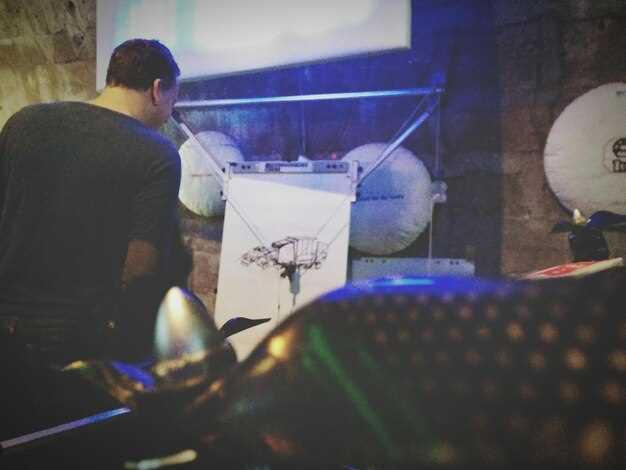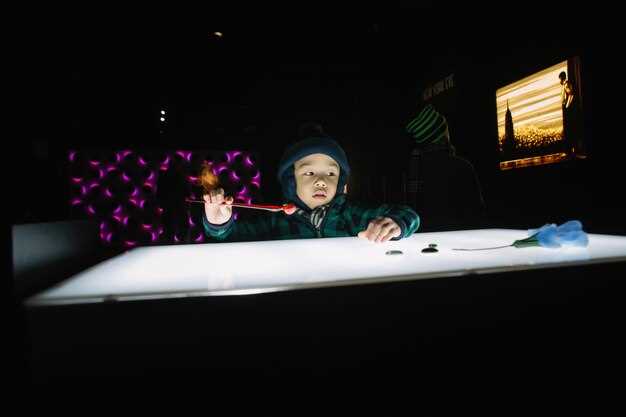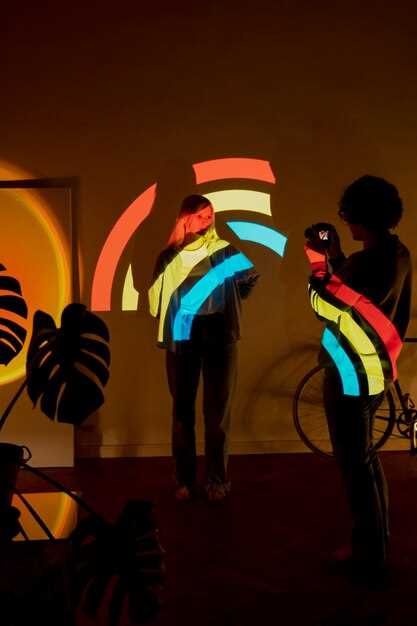Engage with immersive art by exploring installations like Yayoi Kusama’s “Infinity Mirrors” where you step into a kaleidoscope of patterns and lights. It invites viewers to become a part of the art itself, shattering the barrier between observer and exhibition. This type of interactive art encourages participants to reflect on their connection to space and light, providing a tangible understanding of abstract concepts through physical engagement.
To fully appreciate the benefits of interactive art experiences, visit environments such as teamLab’s “Borderless” museum. This digital art museum allows visitors to navigate through dynamic environments where art reacts to their movement. The combination of digital technology and traditional art forms creates a continuously evolving display that fosters a personal connection between the visitor and the artwork. Here, art isn’t static; it becomes a responsive dialogue.
For artists looking to deepen audience engagement, consider incorporating technology like augmented reality (AR) to blend external environments with digital elements. This approach not only captivates but also invites interpretation and manipulation, as seen in installations where users can influence the art via apps or wearable tech. Embrace the challenge of engaging your audience through these innovative techniques, transforming passive observation into active participation.
Utilizing Technology to Enhance Interactive Art

Integrate augmented reality (AR) to transform viewers’ smartphones into magical lenses that add layers of information and imagery over physical art installations. AR can highlight hidden details in exhibits, enriching the spectator’s perception and engagement without altering the integrity of the physical artwork.
- Virtual Reality (VR): Create immersive environments where audiences can explore art in a multi-sensory, simulated world. By generating a 360-degree experience, VR captivates attention and provides an intimate understanding of artworks.
- Motion Sensors: Implement motion-sensing technology that responds to viewers’ movements, allowing them to influence or alter the installation. This interaction encourages participation and personal connection to the art piece.
- Soundscapes: Pair visual art with adaptable audio components that react to visitors’ positions or actions, enhancing emotional resonance and creating a dynamic experience.
Utilize data analytics to tailor experiences based on visitor interaction patterns, facilitating personalized engagements. Use feedback to iterate and adapt displays, maintaining a fresh and appealing environment for both new and returning visitors.
- Incorporate touch-sensitive displays to invite tactile interaction, offering informative or narrative content triggered by a visitor’s touch.
- Introduce projection mapping to transform static pieces into dynamic storytelling mediums, casting animated visuals onto irregular surfaces for dramatic effect.
By strategically combining these technologies, interactive art evolves into a compelling and memorable dialogue between the piece and its audience. Encourage exploration, spark creativity, and immerse participants in an artscape that is continuously evolving with the latest tech advancements.
How Augmented Reality Transforms Viewer Interaction
Integrate augmented reality (AR) into your art exhibition by developing a custom app or using platforms like Artivive. This approach allows users to engage with your art by scanning pieces with their smartphones, bringing digital elements to life. Curate interactive features such as 3D animations or layered storytelling to provide deeper insights into each artwork.
Consider using geolocation to create site-specific experiences. By linking art to its immediate environment, you add context and meaning, making each visit unique. Immersive audio guides that activate upon approaching certain exhibits can further enhance the experience.
Encourage user participation by incorporating interactive AR elements that respond to gestures or facial expressions. This not only captures the viewer’s attention but also fosters a personal connection with the artwork. Interactive components like these can create a sense of play and discovery in traditional spaces.
Collect feedback and data on how users interact with art installations through analytic tools within your AR application. Understanding engagement patterns helps artists and curators refine the experience, tailoring it to audience preferences and behaviors.
By implementing these strategies, AR can transform passive viewers into active participants, enriching their artistic journey and fostering a deeper appreciation for the work presented.
The Role of Virtual Reality in Creating Immersive Environments
Utilize cutting-edge virtual reality (VR) technologies to design spaces that captivate and engage audiences at an unprecedented level. Integrating VR allows creators to transport their audience into meticulously crafted virtual worlds, where interaction is seamless and immersive. Utilize 360-degree video and real-time rendering to enhance this experience, making each viewer feel as if they are a part of the scene unfolding around them.
Incorporate eye-tracking technology to tailor art interactions based on where users focus their attention, creating a more personalized experience. For example, gaze-directed storytelling can guide viewers through a narrative that unfolds differently depending on how they interact with elements in the virtual space. This degree of personalization increases user engagement and keeps them immersed for longer periods.
Leverage VR’s ability to simulate physical presence to create environments that would be impossible or impractical in the real world, such as gravity-defying installations or infinite spatial expansions. This imaginative leeway encourages artists to push traditional boundaries, enabling audiences to experience art in ways never before possible.
Focus on incorporating multi-sensory elements to elevate the immersion provided by VR. Utilize spatial audio to offer a dynamic auditory experience that mimics the way sound naturally interacts within physical spaces. Combine this with haptic feedback to provide tactile responses to user interactions, deepening their connection to the virtual art environment.
Collaborate with technologists and software developers to ensure VR art experiences are accessible to different audiences, including those with varying levels of mobility and sensory abilities. By prioritizing accessibility, a wider range of audiences can participate in and be inspired by these immersive experiences, promoting inclusivity within the interactive art space.
Embrace the potential of VR as a storytelling medium that offers unique possibilities not available in traditional formats. Innovative use of VR in art can transcend the typical static display, making the audience active participants in an unfolding scene, thereby creating a deeply personal and transformative experience.
Integrating Motion Sensors for Interactive Feedback
Begin by incorporating motion sensors to create a responsive environment that engages visitors. Utilize sensors like the Kinect or infrared motion detectors, which can track user movements with precision. Position these sensors at strategic spots within the installation to ensure they capture a wide range of interactions.
Implementing motion sensors allows for dynamic changes in the artwork based on audience movement. For instance, movements can trigger alterations in light, sound, or visual elements. This interactivity makes each visitor’s experience unique, encouraging them to explore further and engage more deeply.
Ensure a seamless experience by calibrating the sensors to avoid lag or unintentional responses. Regularly testing the system ensures reliability and enhances the interactivity. Consider visitor flow patterns and adjust sensor sensitivity to accommodate varying levels of movement for different installations.
For larger spaces, integrate a network of sensors that can communicate with each other. This allows for synchronized reactions across the installation, intensifying the immersive experience. Program these interactions to create a narrative or convey a message through the changes triggered by user movements. Use feedback from users to iterate and refine the system, making the experience more intuitive and engaging over time.
| Sensor Type | Advantage | Recommendation |
|---|---|---|
| Kinect | High precision and reliability | Best for detailed motion tracking |
| Infrared | Simple and cost-effective | Ideal for small to medium spaces |
| Ultrasonic | Long-range detection | Use for large installations |
Exploring the Impact of Artificial Intelligence on Art Engagement
Integrate AI-driven tools into your art spaces to elevate audience engagement. Start by using machine learning algorithms to personalize visitor experiences. AI can analyze visitor preferences and suggest artworks or exhibits tailored to individual tastes, enhancing personal connections with the content.
Consider implementing interactive installations powered by AI. These installations allow audiences to become part of the art through real-time interaction, creating unique experiences every time. For example, AI can modify visual or sound elements based on the visitor’s movements or expressions, fostering a dynamic dialogue between the observer and the artwork.
Explore the potential of AI-generated art to intrigue and engage audiences. By blending AI creativity with human touch, artists can produce thought-provoking pieces that challenge traditional perspectives on authorship and originality. Host exhibitions that showcase these collaborative works to stimulate discussions and reflections on the evolving nature of art creation.
Utilize AI for enhanced accessibility within galleries. AI-powered technologies can provide real-time descriptions, translations, or detailed insights about artworks, making art more inclusive for people with disabilities or language barriers. This approach not only broadens the audience but also enriches the overall visitor experience.
Maintain an open dialogue about the ethical considerations surrounding AI in art. Encourage audience participation in discussions or panels that address questions of copyright, authenticity, and the role of technology in creativity. This engagement not only educates but also empowers visitors to critically engage with contemporary art practices.
Effectively deploying AI within art spaces demands a balance between technological innovation and artistic integrity. By carefully curating these experiences, art institutions can deepen audience engagement and support a more interactive, inclusive, and enriching art environment.
Designing Spaces for Interactive Art Installations

Create adaptable environments that can transform according to the needs of different installations. Flexible spaces encourage artists to experiment and audiences to engage fully. Incorporate modular elements, such as movable walls and furniture, to enhance or alter the layout easily.
Ensure optimal lighting control to accommodate various atmospheres. Implement both artificial and natural lighting options with adjustable intensity and color temperature to suit different interactive experiences. Thoughtfully design the space to allow seamless transitions between different lighting conditions.
Utilize advanced technology by integrating digital components that enhance interactivity. Include options for motion sensors, touchscreens, and augmented reality elements to create a dynamic experience. Keep technical infrastructure discreet to maintain an immersive feel while ensuring easy access for maintenance and updates.
Consider the acoustics of the space to refine soundscapes integral to the immersive experience. Incorporate sound-absorbing materials and strategically placed speakers to deliver pristine audio without interference. Offer customizable sound zones, allowing artists to craft specific acoustic environments for their installations.
Prioritize accessibility to ensure everyone can enjoy the installations. Design paths with various mobility needs in mind and provide clear signage with multiple language options. Ensure interactive components are within reach and intuitive for users of all abilities, creating an inclusive and welcoming environment.
Finally, incorporate sustainable practices by using eco-friendly materials and energy-efficient technologies. This not only reduces the environmental footprint but also resonates with audiences who value ecological responsibility. Install systems for recycling and waste management to maintain cleanliness without disrupting the experience.
Balancing Aesthetic Elements with Functional Requirements
Prioritize visitor experience by integrating user-friendly design with visual appeal. Start by assessing the space where art will be displayed and ensure that pathways and interactive elements are easily accessible. Consider the audience’s movement and sightlines to enhance engagement with the art.
Use technology to merge aesthetics and functionality seamlessly. For instance, employ sensors and responsive materials that react to audience interaction without compromising the artwork’s visual integrity. This encourages viewers to participate actively, enriching their experience.
Collaborate with experts from different fields, such as technologists and designers, to create installations that are both visually captivating and functionally sound. They bring diverse perspectives that help maintain a balance between form and function, ensuring that the final piece resonates on multiple levels.
Test different prototypes with real users to gather feedback and make iterative improvements. This approach helps identify potential issues with accessibility or interaction, allowing for adjustments that enhance both the aesthetic appeal and the user’s interactive experience.
Apply sustainable practices in material selection to align with current environmental demands, while still achieving the desired artistic effect. This not only addresses functional requirements but also adds a layer of purpose and responsibility to the artwork.
Considerations for Accessibility and Inclusivity
Implement audio descriptions for visual art pieces to ensure that visually impaired individuals can fully appreciate the experience. These descriptions should be concise yet detailed, capturing the essence and mood of the artwork.
Ensure text information is presented in large, clear fonts and high contrast colors to support individuals with visual impairments, including those who are colorblind. Avoid red-green and blue-yellow combinations that can be challenging for some visitors.
Offer adaptive devices and equipment such as sensory-friendly spaces and noise-cancelling headphones for individuals with sensory sensitivities, creating a comfortable environment for neurodivergent attendees. Design the layout of exhibitions to be wheelchair accessible, with ramps and wide pathways facilitating smooth navigation.
Provide multilingual support by offering guides and labels in multiple languages. Utilize technology for real-time translation tools to cater to a global audience, enhancing the inclusivity of the experience.
| Inclusion Feature | Purpose |
|---|---|
| Audio Descriptions | Enable engagement for the visually impaired |
| Large, High-Contrast Text | Improve readability for the visually impaired |
| Sensory-Friendly Spaces | Provide comfort for neurodivergent visitors |
| Wheelchair Accessibility | Facilitate easier navigation |
| Multilingual Support | Accommodate a diverse audience |
Strategies for Facilitating Audience Participation
Encouraging active engagement from your audience requires thoughtful strategies that invite interaction and co-creation. Begin by integrating technology that allows participants to influence the artwork in real time. Interactive screens, motion sensors, and augmented reality apps can transform passive observation into a dynamic experience.
- Empower through Choice: Offer attendees decision-making opportunities that impact the art’s outcome or narrative. This could include selecting color schemes, soundscapes, or even storyline directions, creating a personalized and immersive journey.
- Create Collaborative Spaces: Design your exhibit to include areas where participants can contribute physically, such as adding to a collective mural or constructing pieces of a sculpture. This collaboration fosters a sense of ownership and connection to the artwork.
- Use Storytelling Techniques: Engage the audience by weaving stories into the experience. Narratives can be delivered through audio guides, written prompts, or even through live actors, immersing the audience more deeply into the artistic concept.
- Encourage Social Interaction: Design installations that prompt visitors to interact not only with the art but also with each other. Activities that require teamwork or shared decision-making enhance the sense of community and make the experience memorable.
- Provide Feedback Mechanisms: Implement methods for immediate feedback or reflection, such as digital comment boards or interactive surveys at the exhibit’s conclusion. These insights can create a dialogue between the artist and the audience, enriching both sides.
By adopting these strategies, you ensure that every individual becomes an active participant, transforming their experience from viewing art to becoming an integral part of the artistic process itself.
Managing Visitor Flow and Space Utilization
Designate clear pathways to help guide visitors through the space efficiently. Strategically placed signage and floor markings can minimize congestion and create a more enjoyable experience.
- Create Zones: Divide the space into distinct zones based on theme, interaction level, or type of art. This approach allows visitors to choose their path based on interest, reducing overcrowding and enhancing engagement.
- Implement Timed Entry: Limit the number of visitors allowed during specific time slots. This not only controls the flow but also promotes a more intimate experience with the artwork.
- Utilize Technology: Employ mobile apps or digital guides that provide real-time information on crowded areas. This information helps visitors adjust their route, contributing to an evenly distributed flow.
- Interactive Staggering: Encourage engagement in smaller groups by staggering interactive elements. For example, tactile stations or multimedia displays can be duplicated in multiple areas to disperse foot traffic.
- Staff Coordination: Train staff to observe and manage visitor density, offering directions or brief explanations at key points. Their presence can ease navigation and ensure a pleasant experience.
By thoughtfully orchestrating visitor movement and optimizing spatial layout, art experiences become more immersive and accessible, fostering deeper connections between the audience and the artwork.
Video:

Immersive Art Installation by TUNDRA
Immersive Art Installation by TUNDRA
Q&A:

How do immersive art experiences differ from traditional art exhibits?
Immersive art experiences go beyond static displays to engage the audience in dynamic ways. Unlike traditional exhibits, which often involve looking at art from a distance, immersive art invites participants to interact with the artwork. This interaction can involve movement, touch, sound, and even smell. The goal is to create a multi-sensory experience that offers a deeper connection with the artwork, allowing viewers to feel as if they are part of it.
Can you explain the role of technology in creating immersive art experiences?
Technology plays a crucial role by enabling artists to create environments and interactions that would otherwise be impossible. Tools such as virtual reality (VR), augmented reality (AR), and projection mapping help build captivating experiences. For example, VR can transport viewers into a completely different reality crafted by the artist, while AR can overlay digital elements onto the physical world, enhancing the viewer’s interaction with the art.
What impact do immersive art experiences have on audience engagement compared to traditional art forms?
Immersive art experiences tend to significantly increase audience engagement. By allowing participants to become active rather than passive viewers, these experiences create a personal connection to the artwork. This engagement often leads to longer interactions with the art, a deeper emotional response, and a greater appreciation. Additionally, the interactive nature can attract a more diverse audience, including those who might not typically visit traditional art museums.
What challenges do artists face in designing interactive art installations?
Artists face several challenges when creating interactive installations. They must consider how different audiences will interact with their work and ensure that the technology used is accessible and user-friendly. There’s also the challenge of maintaining the art’s integrity while allowing for public interaction, which can sometimes lead to wear and tear. Moreover, artists need to think about how to incorporate technology seamlessly into their art without overshadowing the artistic vision.
Are immersive art experiences suitable for all age groups?
Yes, immersive art experiences can be designed to suit all age groups, but the suitability depends largely on the specific installation and its content. While some experiences are crafted with themes and interactions appropriate for children, others may tackle complex or mature topics better suited for adults. It’s important for visitors to review any age recommendations or restrictions before attending to ensure they choose an experience that aligns with their interests and comfort levels.
How do immersive art experiences differ from traditional art exhibitions in terms of audience engagement?
Immersive art experiences offer a unique form of audience interaction compared to traditional art exhibitions. While traditional exhibitions typically involve observers looking at artwork from a distance, immersive experiences often invite visitors to become part of the art. This might involve interacting with digital elements, moving through specially designed spaces, or participating in sensory experiences that evoke emotions. This form of engagement allows the audience to connect with art on a deeper, more personal level, as they are not just passive viewers but active participants.
Can immersive art installations be educational, and if so, how do they contribute to learning?
Immersive art installations can certainly be educational. They provide dynamic and engaging environments that make learning more memorable and impactful. By using technology and innovative design, these installations can present information in a way that stimulates curiosity and encourages exploration. For instance, a thoughtful interactive exhibit might teach visitors about history, science, or culture by immersing them in a re-created historical setting or allowing them to explore complex data through visual and interactive elements. This kind of engagement not only makes learning more enjoyable but also enhances understanding and retention by involving multiple senses and encouraging active participation.





